A Formidable Gentleman: The Corps of Discovery Meets the Grizzly Bear
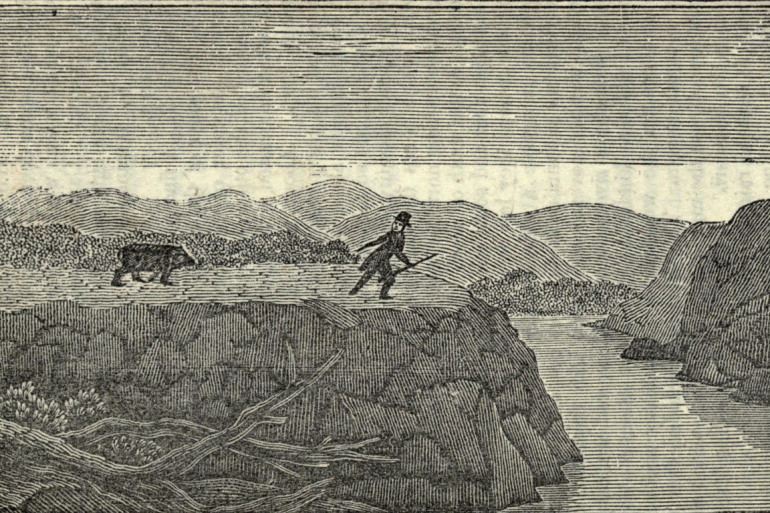
As the Corps of Discovery approached the border of what is now the state of Montana, they anticipated their first meeting with the "grisly" with a mixture of excitement and fear. Well acquainted with the journals of Canadian explorer Alexander MacKenzie, as well as the accounts of the Native American tribes they had encountered along the way, they had gathered as much information as possible on the bear, but still found they knew very little.
They had seen occasional bear sign while passing through present-day South Dakota. According to Lewis, the tracks were "verry large."
On an unseasonably warm Sunday, April 13th, 1805, a week after having left the Mandan, the Corps found a spot on the Missouri where numerous bison had fallen through the ice in winter and collected on the shore following the thaw. Enormous bear tracks wended their way along the shore and in between the heaps of ripening meat, but a disappointed Lewis wrote that "we have not as yet seen one of these anamals... the men as well as ourselves are anxious to meet with some of these bear."
Anxious, yes, but not overly concerned. Lewis admitted in his journal entry for the day that the tribes he had encountered "give a very formidable account of the streng[t]h and ferocity of this anamal, which they never dare to attack but in parties of six eight or ten persons; and are even then frequently defeated with the loss of one or more of their party," while also blithely concluding that "the savages attack this anamal with their bows and arrows and the indifferent guns with which traders furnish them."
The unwritten subtext is this: outfitted as they were with the latest cutting-edge technology, Lewis didn't think the bear would be giving them quite as much trouble.
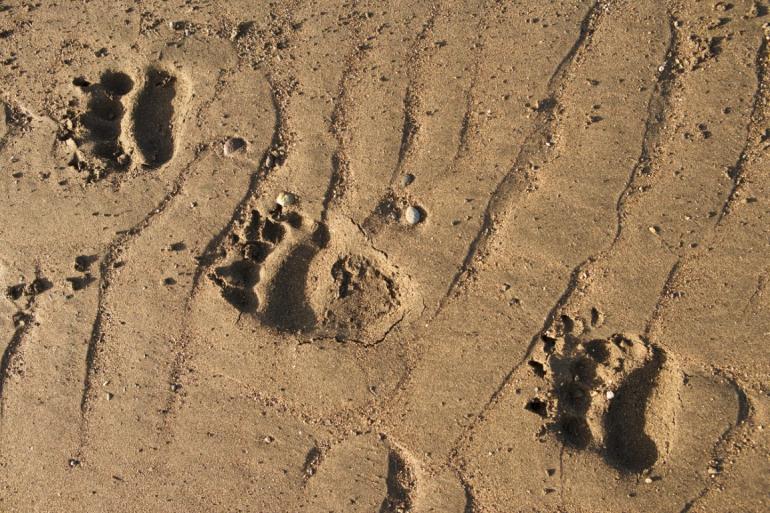
Still, it is hard not to detect a hint of awe in his tone as Lewis relates that "when the Indians are about to go in quest of the white bear, previous to their departure, they paint themselves and perform all those supersticious rights commonly observed when they are about to make war uppon a neighbouring nation."
The next day, they saw more tracks. But still, no bear.
On April 27, they crossed the border of modern-day Montana. The grizzly bear wouldn't make them wait long now.
Just two days later, near present-day Culbertson, MT, they encountered a pair of bears, wounding one and killing the other after it chased Lewis for what he thought was about 80 yards. He estimated the creature's weight at 300 lbs and concluded it was a juvenile. Yes, the creature was "much more furious and formidable" than the black bears to which they were accustomed. Yes, "it is asstonishing to see the wounds they will bear before they can be put to death." Still, Lewis wrote, "in the hands of a skillfull riflemen they are by no means as formidable or dangerous as they have been represented."
It wasn't long before he would come to revise his opinion.
The next week, they encountered an adult grizzly on the shore. The men, eager to claim a trophy, began to fire at the animal. Lewis says ten of their balls pierced it, five "through the lungs." It's hard to read the account today without feeling a little sorry for the bear, which "did not attempt to attack, but fled and made the most tremendous roaring from the moment he was shot."
The killing of the animal provided Lewis another opportunity to study the creature's biology, after which he recorded that "the heart... was as large as that of a large Ox," and that "his maw was also ten times the size of a black bear, and was filled with flesh and fish."
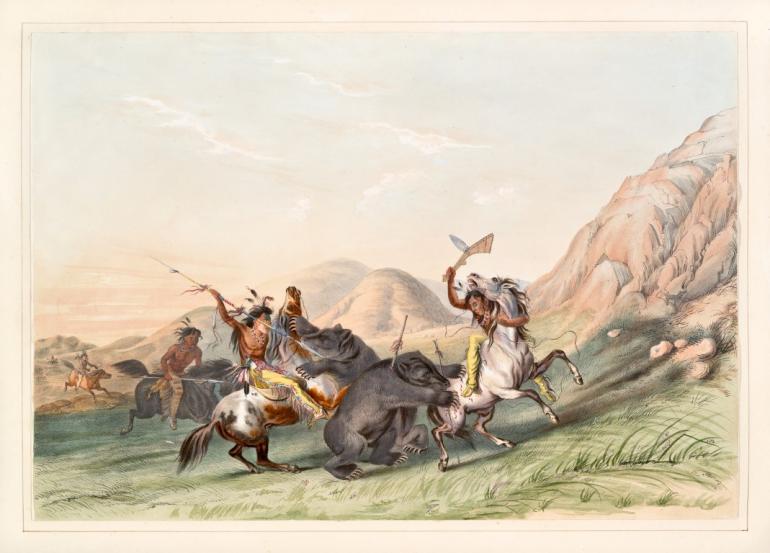
Painting by George Catlin
The very next day, after another close encounter during which they saw a grizzly swimming on the river, Lewis said that "I find that the curiossity of our party is pretty well satisfied with respect to this anamal." Still, he reported, there were yet some members of the expedition who wanted to test their mettle against the bear, and Lewis predicted that they'd get their fill soon enough, when the beasts "begin to coppolate."
Indeed, the breeding season had already begun, and contact with the bear would grow more frequent, and more dangerous.
Five days later, a grizzly chased Private William Bratton after he shot it through the lung. Despite its difficulty breathing, the bear still loped after Bratton for some distance before breaking off. A breathless Bratton told Lewis, who set off, along with seven other hunters, to kill the "gentleman," an appellation Lewis had begun using to refer to the animal. Landowners were "gentlemen," and there seemed no disputing that bears "owned" this land.
Lewis and the hunters found the "gentleman" badly wounded, lying in a two-foot deep depression evidently dug during its pained exertions, and killed it. Lewis notes in his journal that the animal's fleece provided them with eight gallons of oil.
"[T]hese bear being so hard to die reather intimedates us all; I must confess that I do not like the gentlemen and had reather fight two Indians than one bear," he wrote.
Never mind that Lewis had never fought any Native Americans (not yet anyway), and that most of the bears they had met, ferocious by nature or not, got considerably more ferocious after being shot two or three times through the lung with lead balls.
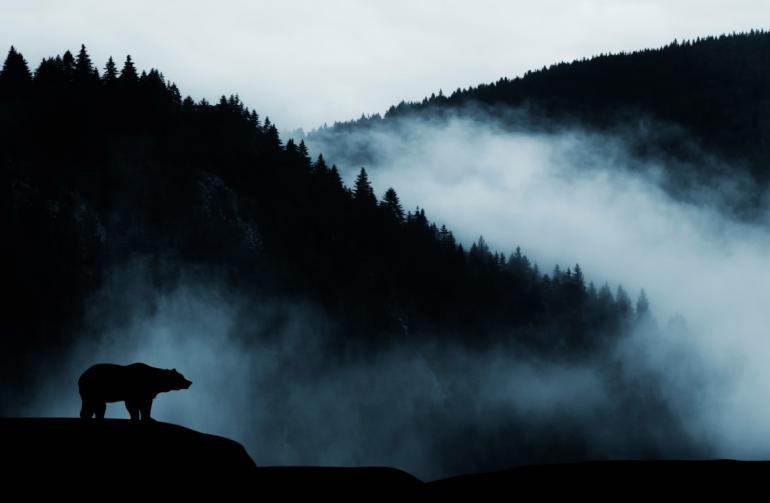
It would only be three days before they had another near-disaster. Several men in the rear canoe saw a grizzly lying a short distance from the shore. Six men ("all good hunters," according to Lewis) snuck up on the bear. Four men shot the bear at once while the other two wisely reserved their fire in case the animal survived the initial volley. It did. They both fired. One bullet struck the bear without effect, while the other "broke his shoulder," momentarily slowing him down and giving the men the chance to hide themselves in the canoe and among the willows. They reloaded and fired when they were able to draw a bead, with several more lead balls finding their target. But their shots also announced their location to the enraged bear, who charged after each puff of smoke in turn. As the bear bore down on them, two of the men threw their guns and powder aside and jumped twenty feet down the steep river embankment into the water.
"So enraged was this anamal," Lewis wrote, "that he plunged into the river only a few feet behind the second man." Then, as the second man struggled to get away, one of the hunters on the shore managed to reload and fire. This last ball went through the bear's head. After taking the corpse ashore, butchering it and rendering its oil, the men found that they had shot it eight times before it succumbed to its wounds.
On June 14th, Lewis would have his own bear encounter while hunting bison near present-day Riverfront Park in Great Falls. After having discharged his rifle, he had forgotten to reload while "gazeing attentively on the poor anamal," allowing a "large white, or reather brown bear" to get within "20 steps" of him. He wheeled around, raised his rifle—and remembered that it was spent.Lewis quickly looked around, even as the bear was approaching. There were no trees, and the bank of the river sloped gently into the water. It would be no hindrance to a grizzly bear. Nevertheless, taking the only option available to him, Lewis ran some 80 yards, and waded into the water up to the depth of his chest. At that depth, he reasoned, he'd be able to stand and use his arms while the bear would be engaging all of his limbs swimming.
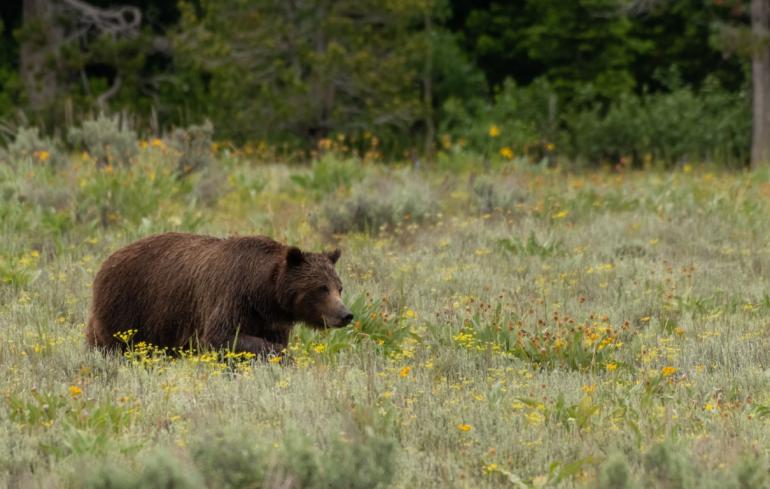
Thus Lewis, making what he thought might be his last stand, "faced about and presented the point of my espontoon", while "at this instant he arrived at the edge of the water within about 20 feet of me..."
As he put himself "in the attitude of defense," he noticed that the bear "sudonly wheeled about as if frightened" and "declined the combat on such unequal grounds," running back to the hills as if terrified.
Later, Lewis wrote that "I now began to reflect on this novil occurrence and indeavoured to account for this sudden retreat of the bear... the cause of his allarm still remains with me misterious and unaccountable." Regardless, he resolved "never again to suffer my peice to be longer empty than the time she necessarily required to charge her."
Bears would require new safety rules for the whole expedition. On June 29, a couple of weeks after Lewis first reached the Great Falls (and 10 days after John Colter, himself famous for the harrowing Colter's Run, was nearly attacked by a grizzly), the explorer's weariness of the constant company of his "gentlemen" companions is palpable.
At the height of the grizzly's feeding season, he wrote that "[t]he White bear have become so troublesome to us that I do not think it prudent to send one man alone on an errand of any kind... they come close around our camp every night but have never ventured to attack us and our dog gives us timely notice of their visits... I have made the men sleep with their arms by them as usual for fear of accedents."
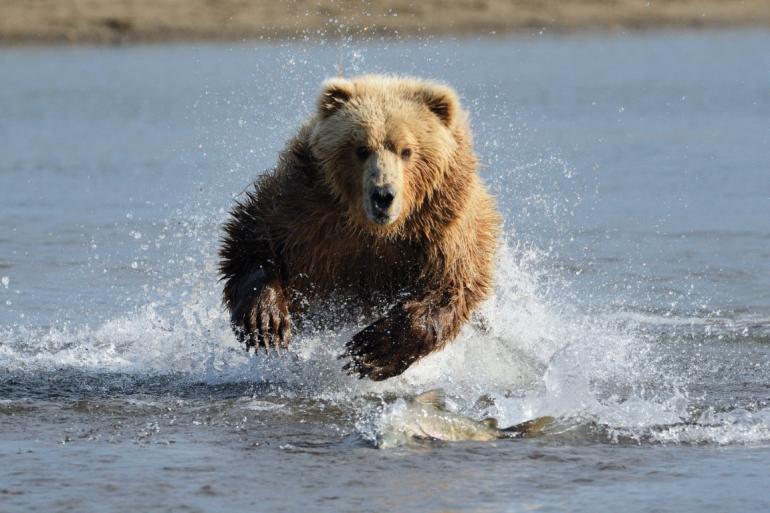
Grizzly sightings dropped off precipitously for the Corps after they emerged west of the Rockies. The next year, after waiting out the winter, they arrived at the west side of the Bitterroots and once again encountered grizzly bears. These Lewis found to be less dangerous than their Missouri River counterparts, possibly, he mused, "from the circumstance of their being compelled from the scarcity of game in this quarter to live more on roots and of course not so much in the habit of seizing and devouring living animals."
They killed at least seven bears while at camp, taking advantage of their comparative docility.
There were to be two more significant grizzly encounters before they returned to St. Louis.
The first was on July 15th, when Lewis sent Private MacNeal to find out whether their cached perogue had survived the winter. MacNeal returned to camp late that evening sporting a broken musket. His horse had passed very close to a grizzly and started, throwing the man under the surprised bear. While the creature reared to its feet, MacNeal had used his rifle as a club, breaking it across the bear's head. While the bear scratched at where he had been hit, MacNeil ran for a nearby willow tree and climbed it. The bear waited until dusk before tiring and walking off, after which MacNeil had collected his horse and went back to camp.
The other was near what is now Glendive. On August 3rd, Clark shot "a Bear of the large vicious Species" after it had "plunged into the water and Swam towards us, either from a disposition to attack't or from the Cent of the meat which was in the Canoe." This particular bear retreated to nurse its wounds, but later that same day, Clark shot another through the head. The second, he noted, "proved to be an old Shee which was so old that her tusks had worn Smooth, and Much the largest female bear I ever saw."
After years of hunting, fighting, and running from Ursus Horribilis, Lewis had to have come to a greater appreciation of the skills of Native hunters who had, with bows and arrows and "indifferent guns," hunted and killed this king of the Rockies.
All told, Lewis and Clark killed an estimated 43 grizzly bears and witnessed countless more, keeping remarkably detailed and largely accurate scientific records all the while.
Most of those bears encountered were in Montana, still the domain of the grizzled gentlemen.
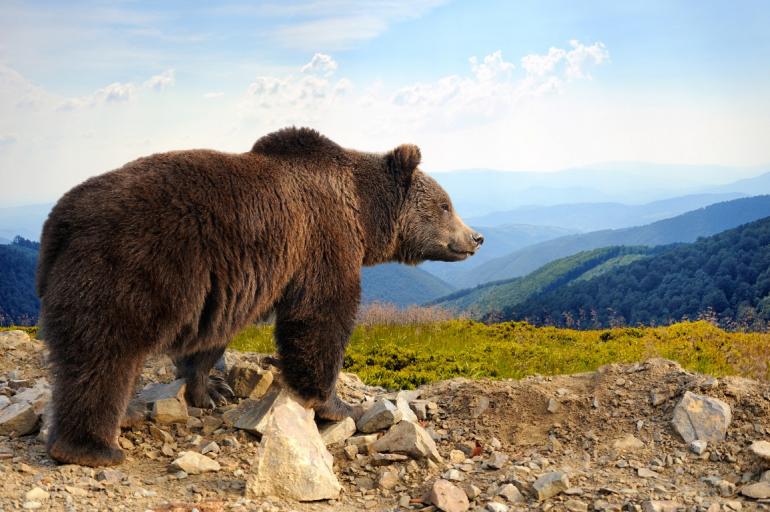
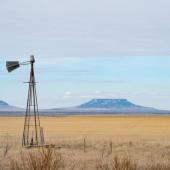


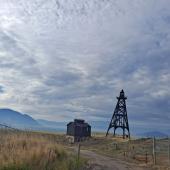



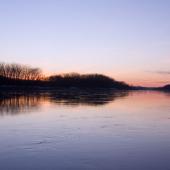
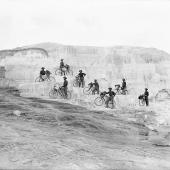
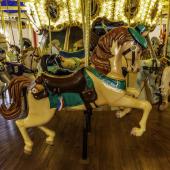
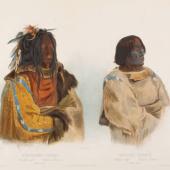
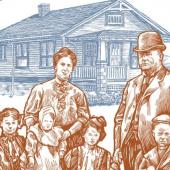
- Reply
Permalink